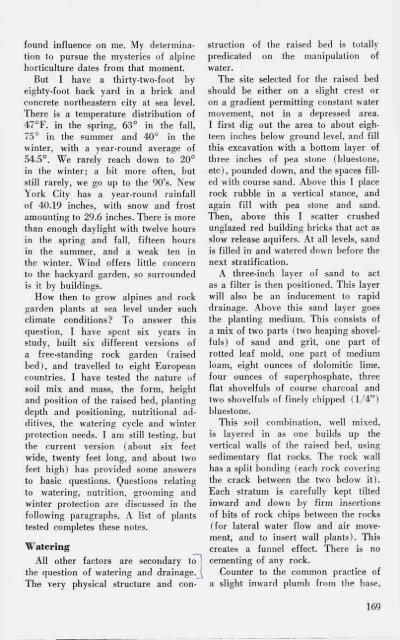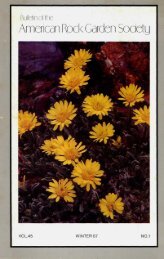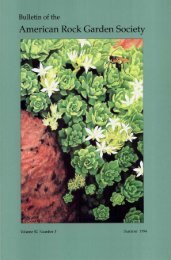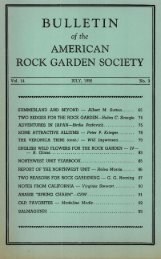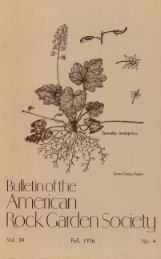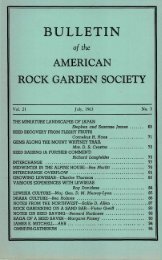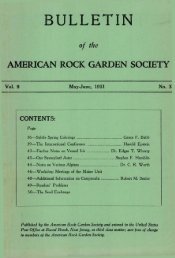Bulletin - Fall 1979 - North American Rock Garden Society
Bulletin - Fall 1979 - North American Rock Garden Society
Bulletin - Fall 1979 - North American Rock Garden Society
Create successful ePaper yourself
Turn your PDF publications into a flip-book with our unique Google optimized e-Paper software.
found influence on me. My determinationto pursue the mysteries of alpinehorticulture dates from that moment.But I have a thirty-two-foot byeighty-foot back yard in a brick andconcrete northeastern city at sea level.There is a temperature distribution of47 °F. in the spring, 63° in the fall,75° in the summer and 40° in thewinter, with a year-round average of54.5°. We rarely reach down to 20°in the winter; a bit more often, butstill rarely, we go up to the 90's. NewYork City has a year-round rainfallof 40.19 inches, with snow and frostamounting to 29.6 inches. There is morethan enough daylight with twelve hoursin the spring and fall, fifteen hoursin the summer, and a weak ten inthe winter. Wind offers little concernto the backyard garden, so surroundedis it by buildings.How then to grow alpines and rockgarden plants at sea level under suchclimate conditions? To answer thisquestion, I have spent six years instudy, built six different versions ofa free-standing rock garden (raisedbed), and travelled to eight Europeancountries. I have tested the nature ofsoil mix and mass, the form, heightand position of the raised bed, plantingdepth and positioning, nutritional additives,the watering cycle and winterprotection needs. I am still testing, butthe current version (about six feetwide, twenty feet long, and about twofeet high) has provided some answersto basic questions. Questions relatingto watering, nutrition, grooming andwinter protection are discussed in thefollowing paragraphs. A list of plantstested completes these notes.WateringAll other factors are secondary to~]the question of watering and drainage. [The very physical structure and constructionof the raised bed is totallypredicated on the manipulation ofwater.The site selected for the raised bedshould be either on a slight crest oron a gradient permitting constant watermovement, not in a depressed area.I first dig out the area to about eighteeninches below ground level, and fillthis excavation with a bottom layer ofthree inches of pea stone (bluestone,etc), pounded down, and the spaces filledwith course sand. Above this I placerock rubble in a vertical stance, andagain fill with pea stone and sand.Then, above this I scatter crushedunglazed red building bricks that act asslow release aquifers. At all levels, sandis filled in and watered down before thenext stratification.A three-inch layer of sand to actas a filter is then positioned. This layerwill also be an inducement to rapiddrainage. Above this sand layer goesthe planting medium. This consists ofa mix of two parts (two heaping shovelfuls)of sand and grit, one part ofrotted leaf mold, one part of mediumloam, eight ounces of dolomitic lime,four ounces of superphosphate, threeflat shovelfuls of course charcoal andtwo shovelfuls of finely chipped (1/4")bluestone.This soil combination, well mixed,is layered in as one builds up thevertical walls of the raised bed, usingsedimentary flat rocks. The rock wallhas a split bonding (each rock coveringthe crack between the two below it).Each stratum is carefully kept tiltedinward and down by firm insertionsof bits of rock chips between the rocks(for lateral water flow and air movement,and to insert wall plants). Thiscreates a funnel effect. There is nocementing of any rock.Counter to the common practice ofa slight inward plumb from the base,169


